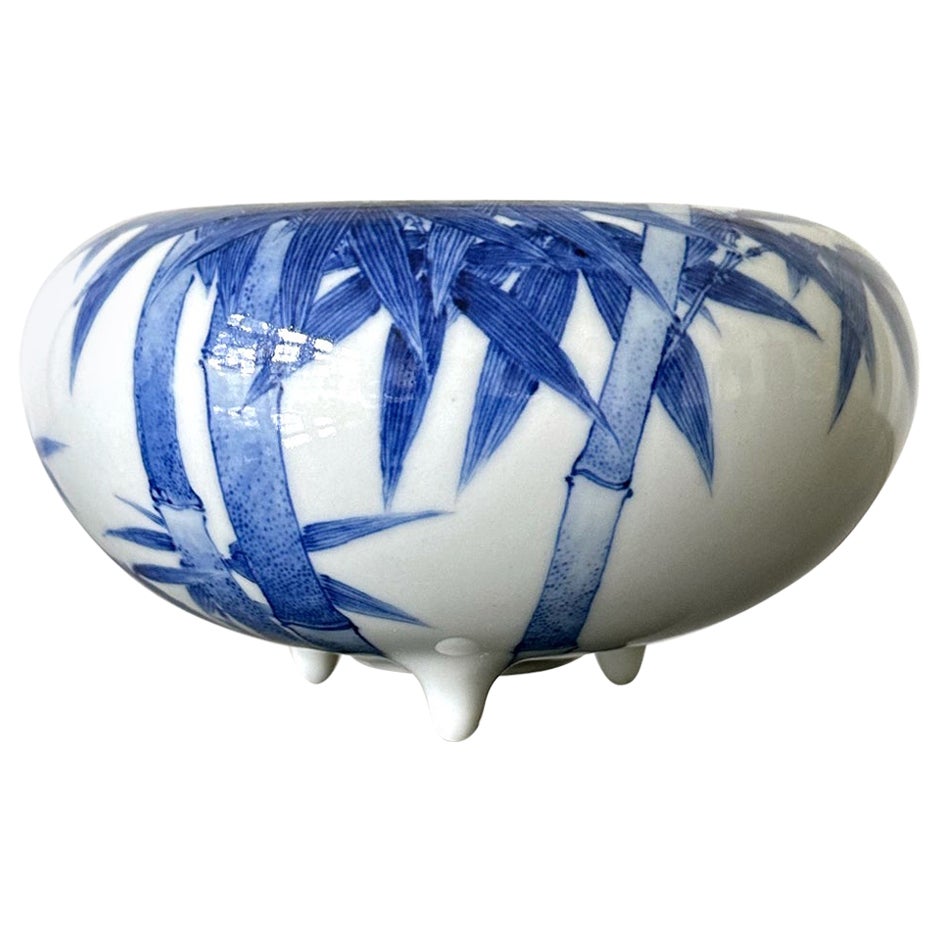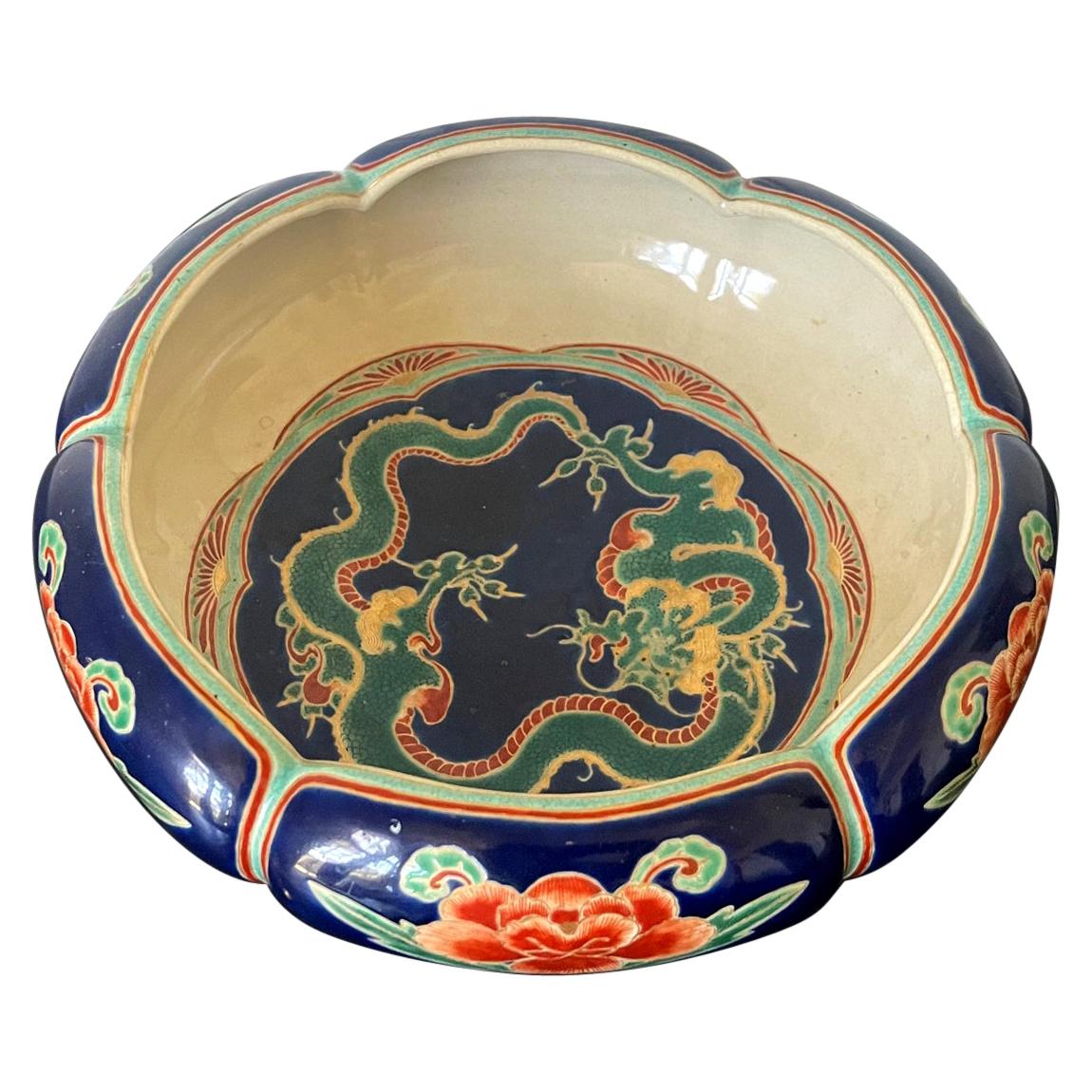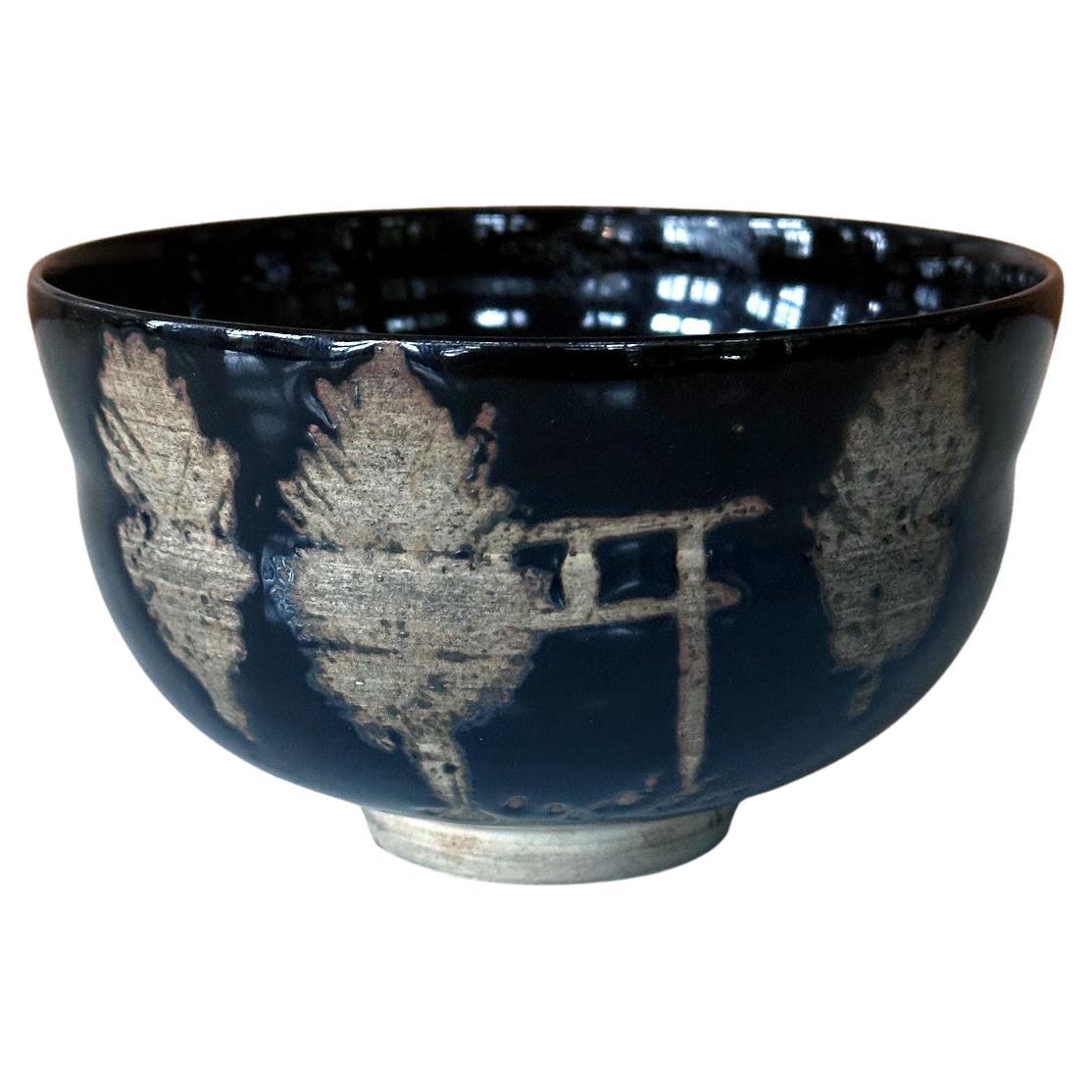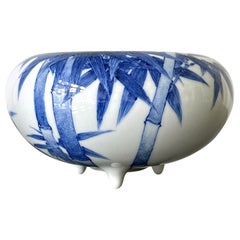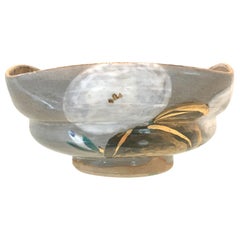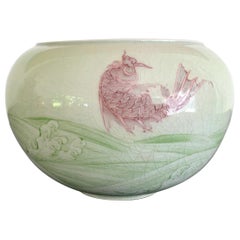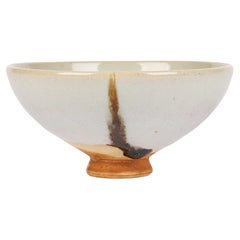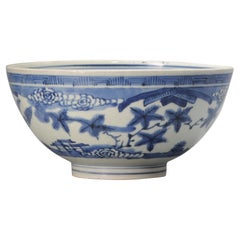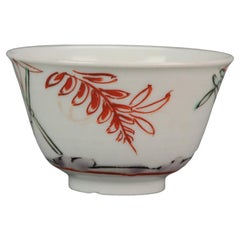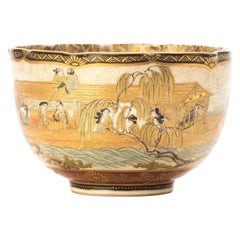Items Similar to Japanese Ceramic Centerpiece Bowl Makuzu Kozan Meiji Period
Want more images or videos?
Request additional images or videos from the seller
1 of 21
Japanese Ceramic Centerpiece Bowl Makuzu Kozan Meiji Period
$9,500
£7,263.26
€8,365.80
CA$13,312.41
A$14,862.06
CHF 7,787.49
MX$181,926.16
NOK 98,901.26
SEK 93,251.33
DKK 62,434.85
About the Item
A beautiful ceramic vessel in the form of Bo, the so-called monk's alms bowl from the studio of Japanese Potter Makuzu Kozan, also known as Miyagawa Kozan (1842–1916), one of the most established and collected ceramist from Meiji Period. Born as Miyagawa Toranosuke, Kozan established his pottery studio in Yokohama circa 1870s and later became one of the appointed artists to the Japanese Imperial household. His work was exhibited in many international fairs that the Meiji government participated at the turn of the century and won many grand prizes.
Of a relatively large size, this piece was made as a decorative center piece for display. It was brilliantly decorated with underglaze paint of a green-on-green bamboo motif, using the novel technique developed by Kozan called Fuki-e (the blow painting). As a result, the bamboos appear took on a three-dimensional quality as if appearing in a mist. Known as one of the most creative ceramists, circa 1887, Kozan started experimenting with new chemical colors from the West in the format of his porcelain glaze. New colors allowed him to create underglaze design that appeared bright, smooth and glossy. To create design that is realistic and dimensional, more common in the western paintings, he was inspired by the native Japanese ink painting technique developed around 1900 by Yokoyama Taikan (1868-1958) and Hishidan Shunso (1874-1911) called Morotai (Hazy style) and used colors on the porcelain like ink on paper. The fuki-e technique was demanding and uniquely featured in the works of Kozan studio.
The vase displays a classic elegant form and a rather unconventional monotoned color scheme. The bamboo decoration climbed the shoulder to reach the mouth rim, another characteristic of the Kozan's work. It was signed underneath in the artist's seal.
For a piece in Khalili Collection, with a similar form and motif but in blue and white. see figure 240 on page 343 of "Splendors of Imperial Japan. Arts of the Meiji Period from the Khalili Collection". See detail photo.
A vase with similar bamboo motif and green color was exhibited in "Meiji, Splendors of Imperial Japan" in Musee Guimet Paris, 2018. See detail photo.
- Creator:Makuzu Kozan (Artist)
- Dimensions:Height: 6.5 in (16.51 cm)Diameter: 12 in (30.48 cm)
- Style:Japonisme (Of the Period)
- Materials and Techniques:Ceramic,Glazed
- Place of Origin:
- Period:1900-1909
- Date of Manufacture:1900-1910
- Condition:Wear consistent with age and use. Fine condition with minimal shelf wear. A minute kiln speck inside as shown.
- Seller Location:Atlanta, GA
- Reference Number:1stDibs: LU945029507352
About the Seller
4.9
Platinum Seller
Premium sellers with a 4.7+ rating and 24-hour response times
Established in 2006
1stDibs seller since 2010
565 sales on 1stDibs
Typical response time: <1 hour
- ShippingRetrieving quote...Shipping from: Atlanta, GA
- Return Policy
Authenticity Guarantee
In the unlikely event there’s an issue with an item’s authenticity, contact us within 1 year for a full refund. DetailsMoney-Back Guarantee
If your item is not as described, is damaged in transit, or does not arrive, contact us within 7 days for a full refund. Details24-Hour Cancellation
You have a 24-hour grace period in which to reconsider your purchase, with no questions asked.Vetted Professional Sellers
Our world-class sellers must adhere to strict standards for service and quality, maintaining the integrity of our listings.Price-Match Guarantee
If you find that a seller listed the same item for a lower price elsewhere, we’ll match it.Trusted Global Delivery
Our best-in-class carrier network provides specialized shipping options worldwide, including custom delivery.More From This Seller
View AllJapanese Glazed Ceramic Bowl by Makuzu Kozan
By Makuzu Kozan
Located in Atlanta, GA
Tri-pod ceramic bowl likely used as an incense burner (koro) by Japanese Imperial potter Makuzu Kozan (1842-1916) circa late Meiji period. The signature indicates that it was produce...
Category
Antique 1880s Japanese Meiji Ceramics
Materials
Ceramic
Rare Japanese Ceramic Glazed Bowl Makuzu Kozan Meiji Period
By Makuzu Kozan
Located in Atlanta, GA
On offer is a rare ceramic bowl with overglazed design by the famed Japanese ceramic artist Makuzu Kozan (1842-1916), circa 1906-1916. The bowl is rather unusual from the potter's repertoire with its unique glaze colors and decoration, and it likely belonged to a small series that Kozan made in and after 1906. A bowl of similar glaze and nearly identical dragon motif was recorded as a diplomatic present to the British royalty Arthur Connaught (1883-1932) when he represented King Gorge V in Japan in 1906. Other pieces, such as this bowl, were likely made with similar materials and designs afterwards.
Essentially round in form, the bowl has a generous volume with six harmonious lobes. The bottom of the interior showcases a coiled dragon in red, green and gold slithering on a cobalt blue background. The roundel shares an echoing lobed perimeter, which is further outlined by red and turquois bands and rising sun design. The exterior of the bowl features six stylized Japanese camellias...
Category
Antique Early 1900s Japanese Japonisme Ceramics
Materials
Ceramic
Japanese Ceramic Bowl Makuzu Kozan Utusushi Kenzan
By Makuzu Kozan
Located in Atlanta, GA
A rare ceramic bowl with overglaze paint decoration by Japanese imperial potter Makuzu Kozan ((1842–1916). Unlike the better-known works Kozan made for the expositions in the west and export to the foreign market, this piece exemplifies his work for the domestic market and the tea ceremony. The bowl was made in the so called "Utusushi" Ogata Kenzan (1663-1743), a celebrated Edo painter and ceramicist. Utusushi is loosely translated as "in the spirit of". It is not at all a simple imitation of a master, but a Japanese concept of embracing the spiritual essence of a master while the creator is free to mix in his or her own unique artistic interpretation and flavor.
The bowl was made to hold fruits during the tea ceremony. It has a very distinguished form with a circular lower body morphing into a square upper portion that further opening with flared rim. The surface has a grey glaze onto which Asagao flowers (Japanese morning glory) on the vines were painted in a free and poetic style. White was used for the petals, green for the leaves with touches of gold highlight. Asagao, the symbol of the summer was rendered in the spirit of Ogata Kenzan, and interestingly the shape of the blossom echoes the unique form the bowl. It was likely reserved for the tea ceremony during the summer months.
Under the base, Kozan was signed in black on a white porcelain plaque inlay.
For two similar examples of Kozan's work Utusushi Kenzan, see Page 168-169 of the book: Sekai ni Aisa Reta ya Kimono Miyagawa Kozan Makuzu...
Category
Antique Early 1900s Japanese Japonisme Ceramics
Materials
Ceramic
Rare Porcelain Bowl with Plique-a-Jour Design by Makuzu Kozan
By Makuzu Kozan
Located in Atlanta, GA
An extremely fine and delicate porcelain bowl from the studio of Japanese Potter Makuzu Kozan, also known as Miyagawa Kozan (1842–1916), one of the most established and collected cer...
Category
Antique Early 1900s Japanese Japonisme Ceramics
Materials
Porcelain
Japanese Glazed Kyo-yaki Tea Bowl Nin'ami Dohachi Edo Period
Located in Atlanta, GA
A Japanese chawan (tea bowl) of Kyo-yaki (Kyoto ware) attributed to Nin'ami Dōhachi, also known as Takahashi Dōhachi (1783–1855). Potted sensitively wi...
Category
Antique 19th Century Japanese Edo Decorative Bowls
Materials
Ceramic
Japanese Shino Chawan Tea Bowl Edo Period
Located in Atlanta, GA
A Japanese ceramic Chawan (tea bowl) of e-Shino (painted Shino) ware style circa mid-late 18th century Edo period. The classically shaped bowl features an abstract blue paint of blue grass and displays strong characters in the milky white glaze, with overall crawling and crackling effect. One of the most distinctive characteristics of Shino that is exemplified on this bowl is the small pinholes called suana, which tea masters favor (termed as yuzuhada, or citron skin). The milky-white feldspar...
Category
Antique Late 18th Century Edo Ceramics
Materials
Ceramic
You May Also Like
Chinese Jun Ware Streak Glazed Art Pottery Bowl
Located in Bishop's Stortford, Hertfordshire
A very stylish good quality Chinese Jun Ware pottery bowl decorated with streaked glazes on a red and pale blue glazed ground dating from the latter 19th o...
Category
Antique 19th Century Chinese Other Ceramics
Materials
Pottery
Antique Japanese Arita Porcelain Bowl Japan Top Quality, ca 1670-1690
Located in Amsterdam, Noord Holland
A lovely antique bowl from Arita, Japan. The outside wall with an ongoing landscape scene and the inside also with a nice landscape scene in a circle.
Additional information:
Materi...
Category
Antique 17th Century Japanese Decorative Bowls
Materials
Porcelain
$1,699 Sale Price
20% Off
Antique Japanese Porcelain Tea Bowls Arita, 18th Century
Located in Amsterdam, Noord Holland
A very nice example with a lovely scene.
Rather unusual.
Additional information:
Material: Porcelain & Pottery
Type: Tea Bowls & Cups, Tea Drinking
Color: Other
Maker: Qianlong (17...
Category
Antique 18th Century Chinese Decorative Bowls
Materials
Porcelain
$322 Sale Price
20% Off
A Japanese Satsuma ceramic lobed bowl
Located in Milano, IT
Satsuma ceramic lobed bowl with curved corners and embellished with a refined scene of daily life along a watercourse on the outside. The interior is adorne...
Category
Antique Late 19th Century Japanese Japonisme Ceramics
Materials
Ceramic
$3,213 Sale Price
20% Off
Small Satsuma Earthenware Bowl
Located in Lymington, Hampshire
A small Satsuma earthenware bowl, painted in overglaze enamels and gilt with three fans. Japanese, circa 1900.
Measures: Height 2 inches Diamete...
Category
Antique Early 1900s Japanese Ceramics
Materials
Ceramic
Japanese Porcelain Matcha Bowl for Tea Ceremony Kyo Ware Toraku MORISATO
Located in Paris, FR
This is a bowl that we use during tea ceremony. This is made with porcelain and it was made around 1980 in Showa era. This bowl has a style Kyo raku. It is called Kyo ware and it was...
Category
Vintage 1980s Japanese Showa Decorative Bowls
Materials
Porcelain
More Ways To Browse
Imperial Japan
Blue Glaze Japan
White Ceramic Centerpiece
Japanese Blue And White Ceramic
Antique Japanese Seals
Pottery Bowl Japan
Japanese Bowl Signed
Japanese Monk
Japanese Blue Bowl
Large Blue Ceramic Bowl
Large White Ceramic Bowl
Meiji Figure
Japanese Meiji Bowl
Meiji Period Bowl
Japanese Green Pottery
1887 Porcelain
Antique Green Pottery Bowl
Bamboo Porcelain Vase
